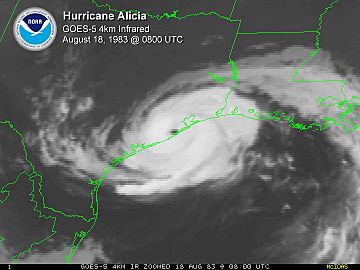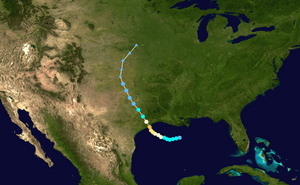Hurricane Alicia facts for kids
| Category 3 major hurricane (SSHWS/NWS) | |

Hurricane Alicia making landfall on Texas.
|
|
| Formed | August 15, 1983 |
|---|---|
| Dissipated | August 21, 1983 |
| Highest winds | 1-minute sustained: 115 mph (185 km/h) |
| Lowest pressure | 963 mbar (hPa); 28.44 inHg |
| Fatalities | 21 direct |
| Damage | $2.6 billion (1983 USD) |
| Areas affected | Mostly Texas |
| Part of the 1983 Atlantic hurricane season | |
Hurricane Alicia was the first named storm and the first hurricane of the 1983 Atlantic hurricane season. Alicia was the strongest and deadliest storm that year. It caused the deaths of 21 people and led to about $2.6 billion in damage (in 1983 money). Alicia was the most destructive hurricane to hit Texas since Hurricane Carla in 1961.
Hurricane Alicia started as Tropical Depression Three on August 15 in the Gulf of Mexico. It slowly moved west towards Texas. On August 18, it hit land at its strongest point with winds of 115 mph (185 km/h). Alicia quickly became weaker after moving inland. It turned into a tropical depression before disappearing completely on August 21.
Contents
Storm's Journey
A small area of low pressure formed near the coasts of Alabama and Mississippi on August 14. This low pressure area grew stronger and became Tropical Depression Three on August 15. A ship nearby reported low pressure, and the storm was upgraded to Tropical Storm Alicia later that day.
Because of high pressure in the Gulf, Alicia stayed very small. However, its winds became faster, and it turned into a Category 1 hurricane on August 16. The winds that guide storms were weak, so Alicia moved slowly over the water. A new weather system formed on August 17, which made the storm slowly move west.
Alicia then began to move more to the north on August 18, heading towards Port Arthur, Texas. During this time, the hurricane got much stronger, reaching its peak with winds of 115 mph (185 km/h). Just before hitting land, Alicia showed a rare "double eye" for a few hours. The storm hit land in Texas as a Category 3 hurricane around 1:45 a.m. CDT on Thursday, August 18.
Alicia quickly lost strength after hitting land. It lost its tropical features and sped up towards the northwest. It finally disappeared in southeast Nebraska on August 21.
Getting Ready for the Storm
People were given several hurricane watches and warnings for Alicia. The first warnings were for strong winds and a hurricane watch for the area from Corpus Christi, Texas to Grand Isle, Louisiana on August 16. On August 17, a hurricane warning was given for Corpus Christi to Morgan City, Louisiana, and later for Port Arthur, Texas.
At first, many people did not take these warnings seriously. The mayor of Galveston, E. Gus Manuel, only told people in low-lying areas to leave. This was against the advice of Texas Governor Mark White.
When Hurricane Allen threatened Texas in 1980, 30 percent of Galveston's population left the island. But when Alicia hit, only 10 percent of the people living behind the seawall chose to leave. As the day went on, strong winds started causing damage in Galveston, and people became more worried. The mayor finally ordered everyone on the island to leave after midnight on August 18. However, by then, the bridges to the mainland were broken and could not be used.
What Happened After the Storm
In Texas
Galveston city reported 7¾ inches of rain. Liberty had 9½ inches, and Greens Bayou got almost 10 inches of rain. In the Houston area, some places in Harris County received about 10-11 inches of rain. Strong wind gusts were also reported across Texas. A maximum gust of 125 mph was recorded on a Coast Guard ship near Galveston Island.
The water levels (tides) were very high. Pleasure Pier reported tides of 8.67 feet. Baytown, Texas, saw tides of 10–12 feet, and Morgan City had the highest recorded tide from Alicia at 12.1 feet.
Twenty-three tornadoes were caused by or related to Alicia. Fourteen of these tornadoes were in the Galveston and Hobby Airport area. The other nine were around Tyler and Houston, with some reaching F2 on the Fujita scale. An oil spill happened near Texas City, Texas. A large tugboat also flipped over 50 miles off the Sabine Pass coast.
The Coast Guard Air Station Houston had only minor damage. After the storm, their helicopters helped people by flying supplies, checking damage, and helping with evacuations.
The National Weather Service office in Galveston temporarily lost its radar. Houston suffered billions of dollars in damage. Many glass windows in tall buildings downtown were broken by gravel blown off rooftops. Houston Lighting and Power reported that about 750,000 homes lost electricity after Alicia hit. Many stores had to stay closed for days because of the danger of falling glass.
In Galveston, the public beach on the western side moved back about 150 feet. A whole wall of the Flagship hotel collapsed. About 5 feet of sand was washed away, leaving beachfront homes without their natural protection. These homes then broke the Texas Open Beaches Act, and the government said they could not be repaired or rebuilt. The Corps of Engineers said that if the Galveston Sea Wall had not been there, another $100 million in damage could have happened.
Hurricane Alicia also damaged chemical and petrochemical factories in Houston. Hurricane Carla in 1961 hit an area with fewer people. If Alicia had been as big or strong as Carla, the damage could have easily doubled or even tripled.
In Other States
Heavy rainfall was recorded in the southern-central part of Texas, with 8-14 centimeters of rain. Kansas received 1-3 inches of rain in its eastern and central parts. The southeast part of Nebraska got one inch of rain from Alicia's leftover storm. Michigan, Iowa, Minnesota, Louisiana, and Wisconsin all received one inch of rainfall.
Hurricane Alicia brought helpful rains to the southern Great Plains. This area had been suffering from a drought for most of the summer of 1983. In the end, Hurricane Alicia killed 21 people and caused $2 billion in damage.
Aftermath and Name Retirement
Aftermath
The Red Cross helped 63,000 people by providing food and shelter after the hurricane. This cost about $166 million. FEMA (Federal Emergency Management Agency) gave out $32 million (in 1983 money) to people affected by Alicia and to local governments. About $23 million of that money was used to clean up trash and damaged items left by the storm. More than 16,000 people asked for help from FEMA's disaster service centers.
The Small Business Administration helped over 16,000 victims and expected about 7,000 loan applications. The Federal Insurance Agency closed over 1,318 flood insurance cases from Alicia's effects. However, only 782 of these received a final payment.
In September 1983, two groups from the U.S. House of Representatives held meetings in Houston. The first meeting on September 23 looked at how the National Weather Service (NWS) performed during Alicia. They also discussed how effective the NWS was in general. The second meeting on September 24 talked about the damage and the efforts to recover after Alicia.
At the September 23 meeting, witnesses agreed that the National Weather Service did a great job before and during the emergency caused by Alicia. NWS forecasters said their predictions were "on target" and that local emergency plans worked well, which saved many lives. Mayor Gus Manuel of Galveston said the NWS did an excellent job. He was very impressed with their predictions about where Alicia would hit land on August 17.
At the September 24 meeting, it was clear that there was a need to improve how cities get ready for disasters like Alicia. Mayor Manuel said that his town needed stronger building rules, which were being reviewed.
Retirement
The name Alicia was taken out of the list of hurricane names in the spring of 1984. This means it will never be used again for an Atlantic hurricane. It was the 30th storm name to be retired. The name Allison replaced Alicia for the 1989 Atlantic hurricane season. Coincidentally, the name Allison was also retired after causing a lot of damage to the same area in 2001.
Fun Facts
- Hurricane Alicia was the last major hurricane (Category 3 or stronger) to hit Texas until Hurricane Bret in 1999.
- Alicia was the first storm for which the National Hurricane Center started to predict the chances of where it would hit land.
- Alicia was Texas's first storm to cause over a billion dollars in damage.
- It hit southeast Texas, becoming the first hurricane to hit the U.S. mainland since Hurricane Allen in September 1980. The time between these two storms was three years and eight days (998 days). This was the longest time without a hurricane hitting the U.S. mainland since a period from September 1929 to August 1932.
Related Pages
- NHC Alicia Report
Images for kids
See also
 In Spanish: Huracán Alicia para niños
In Spanish: Huracán Alicia para niños






